

Food and Agriculture Organization of the United Nations, for a world without hunger. CODEX Alimentarius. CXS 193-1995General Standard for Contaminants and Toxins in Food and Feed CXC 1-1969General Principles of Food Hygiene CXS 1-1985General Standard for the Labelling of Prepackaged Foods CXG 2-1985Guidelines on Nutrition Labelling CXM 2Maximum Residue Limits (MRLs) and Risk Management Recommendations (RMRs) for Residues of Veterinary Drugs in Foods CXS 192-1995General Standard for Food Additives CXC 80-2020Code of Practice on Food Allergen Management for Food Business Operators.
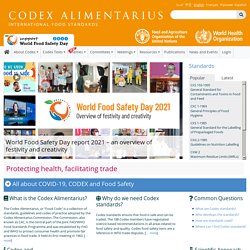
U S Food and Drug Administration. Monsanto - A Sustainable Agriculture Company. Monsanto Maize: EU Blocks France Ban. Days after France attempted to ban a genetically-modified strain of maize created by the controversial agricultural company Monsanto, based in St.
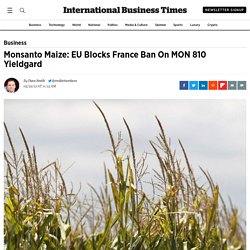
Louis, Mo., the European Food Safety Authority (EFSA) rejected France's grounds for banning the maize on Monday, even though France believes the corn is harmful to the environment. Based on the documentation submitted by France, there is no specific scientific evidence, in terms of risk to human and animal health or the environment, the EFSA said on its website. Monsanto's maize, known as MON 810 or its trade name YieldGard, was introduced in 1997 as corn with naturally-occurring soil bacteria inserted into its DNA structure that could better resist insects, as the pests simply can't digest the protein produced by the bacterium.
But while the GM maize can keep stalk borers away, some experts believe the crop can be harmful to plants and other animals. Death of the Bees. This article was originally published by Global Research in March 2008 Commercial beehives pollinate over a third of [North}America’s crops and that web of nourishment encompasses everything from fruits like peaches, apples, cherries, strawberries and more, to nuts like California almonds, 90 percent of which are helped along by the honeybees.

Without this pollination, you could kiss those crops goodbye, to say nothing of the honey bees produce or the flowers they also fertilize’.1 This essay will discuss the arguments and seriousness pertaining to the massive deaths and the decline of Bee colonies in North America. As well, it will shed light on a worldwide hunger issue that will have an economical and ecological impact in the very near future. Genetically modified seeds are produced and distributed by powerful biotech conglomerates. Beeologics. Beeologics LLC is an international firm dedicated to restoring bee health and protecting the future of honey bee pollination.

Beeologics’ mission is to become the guardian of bee health worldwide. Through continuous research, scientific innovation, and a focus on applicable solutions, Beeologics is developing a line of RNAi-based products to specifically address the long-term well being of honey bees, including the control of parasites and how they’re involved in Colony Collapse Disorder (CCD). With offices and laboratories in the United States and Israel, Beeologics brings together some of the world’s most recognized virologists and microbiologists to help achieve its mission.
To date, Beeologics is the only company to make a scientific breakthrough on the road to protecting bees from viruses. The Buzz on Beeologics. K.

Humphrey 5/14/2012 What do Monsanto and honey bees have in common? Beeologics. Beeologics, acquired by Monsanto a year ago, researches and is developing biological tools to provide targeted control of pests and diseases, including those that are related to Honey Bee health. AquAdvantage salmon. Aquaculture[edit] Commercial aquaculture is the most rapidly growing segment of the agricultural industry, accounting for more than 60 million tons in 2012, versus 90 million tons of wild caught fish.
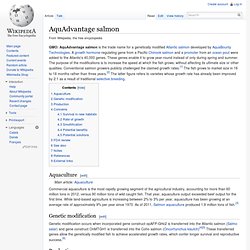
That year, aquaculture output exceeded beef output for the first time. While land-based agriculture is increasing between 2% to 3% per year, aquaculture has been growing at an average rate of approximately 9% per year since 1970. As of 2011, Salmon aquaculture produced 1.9 million tons of fish. Genetic modification[edit] Genetic modification occurs when incorporated gene construct opAFP-GHc2 is transferred into the Atlantic salmon (Salmo salar) and gene construct OnMTGH1 is transferred into the Coho salmon (Oncorhynchus kisutch) These transferred genes allow the genetically modified fish to achieve accelerated growth rates, which confer longer survival and reproductive success.[6] Production[edit] Concerns[edit] Survival in new habitats[edit] Rate of growth[edit] Smoltification[edit] Subsidizing Starvation. In the wake of Haiti's devastating 7.0-magnitude earthquake exactly three years ago, former U.S.

President Bill Clinton issued an unusual and now infamous apology. Calling his subsidies to American rice farmers in the 1990s a mistake because it undercut rice production in Haiti, Clinton said he had struck a "devil's bargain" that ultimately resulted in greater poverty and food insecurity in Haiti. "It may have been good for some of my farmers in Arkansas, but it has not worked," he said.
"I have to live every day with the consequences of the lost capacity to produce a rice crop in Haiti to feed those people, because of what I did. " Against US Agricultural Subsidies. March, 2009 by Sam King I am not against all subsidies.
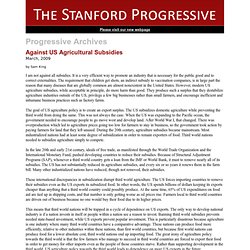
It is a very efficient way to promote an industry that is necessary for the public good and to correct externalities. The requirement that children get shots, an indirect subsidy to vaccination companies, is in large part the reason that many diseases that are globally common are almost nonexistent in the United States. However, modern US agriculture subsidies, while acceptable in principle, do more harm than good. The goal of US agriculture policy is to create an export surplus.
In the late 20th and early 21st century, ideals of free trade, as manifested through the World Trade Organization and the International Monetary Fund, pushed developing countries to reduce their subsidies. These international discrepancies in subsidization disrupt third world agriculture. 2012 World Hunger and Poverty Facts and Statistics by World Hunger Education Service. 2015 World Hunger and Poverty Facts and Statistics World Hunger Education Service.
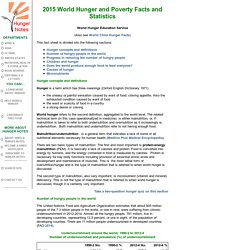
Long, hot summer sends food prices soaring. A summer of droughts and extreme temperatures across the world threaten the planet's most vulnerable people, as food prices rise.
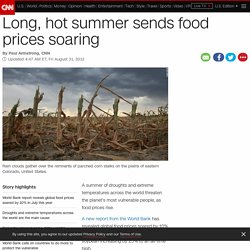
Organic Food Purists Worry About Big Companies’ Influence.